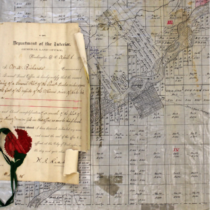Magazine

Could U-M Have Been In Ohio?
A Bentley historian investigates an Ohio historical marker that claims U-M was once destined to be located in the Buckeye State.
By Andrew Rutledge
The area along the Michigan-Ohio border was once hotly contested between the two states, and a war was nearly fought over it in 1835. And it’s in this contested stretch where the University of Michigan’s campus was first going to be built—or, at least that’s what one historical marker in Toledo, Ohio, claims. But is it true?
“One of Toledo’s oldest neighborhoods and originally in Michigan, Huron St. Village was considered as the site of the University of Michigan,” reads the marker. But “after the outcome of the Michigan-Toledo War of 1835, the area was permanently established in Ohio and averted the proposed location of the university from here.”
During the Toledo War, Ohioans and Michiganders came to blows over the strip of land along the Maumee River where Toledo now stands. Eventually, Congress intervened, and Michigan only became a state after surrendering all claims to the area. But there are no records suggesting U-M ever considered basing itself in Toledo. So how did this marker come to exist?
The answer lies in U-M’s many connections with Toledo and its nearby lands. In September 1817, as part of the Treaty of Fort Meigs, negotiated just upstream from Toledo, members of the Odawa, Ojibwe, and Bodewadomi tribes granted six sections of land to the Catholic Church in Detroit and “to the corporation of the college at Detroit” founded just weeks before. The college would become the University of Michigan and the sale of those lands was key in keeping its doors open during its early years.
The lands along the Maumee River, however, had historically been a home to the Miami, Wyandot, and Anishinaabe peoples who were forced from the area by coercive treaties in the early 19th century. In late 1816, these lands were opened for sale to American citizens. A decade later, Congress passed a law setting aside “a quantity of land, not exceeding two entire townships” in Michigan territory “for the use and support of the University.” Desperate for funds, the Trustees who oversaw U-M’s operations, quickly appointed a committee to select these lands—not to build on them, but to claim them, then sell them for profit.
On June 25, 1827, the Trustees voted to claim Lots 1, 2, 7, 8, 9, and 10 on Swan Creek in what is now downtown Toledo as part of those granted by Congress. Together they totaled 915.55 acres.
Former Cincinnati Mayor Martin Baum and his partner William Oliver had invested deeply in the Toledo area and eagerly sought to buy these lots. But negotiations dragged and the Trustees only accepted their offer of $5,000 for Lots 1 and 2 in 1834. By then, however, the controversy over the Toledo Strip was in full force and the area’s legal status uncertain.
When Congress forced Michigan to cede control of Toledo to Ohio, it took a special Act of Congress in 1837 to allow the Trustees to sell lands that were now outside of the state. The remaining lots continued to be University property into the 1850s.
In late 2023, Brian Miller, records manager for the engineering department of Lucas County, Ohio, was looking through archived township documents and discovered a map showing U-M’s lands in Toledo. Dating from 1904, it was an exact copy of an administrative map to manage land transactions from the early 1800s. Miller shared scans of the map with the Bentley, which, when combined with the early University records already in the archive, revealed a little-known history of U-M’s connections with Toledo.
Those connections likely mixed with the Toledo War in popular memory, forming the belief U-M was once destined to be in Ohio.
